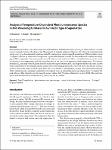Thông tin tài liệu
Thông tin siêu dữ liệu biểu ghi
| Trường DC | Giá trị | Ngôn ngữ |
|---|---|---|
| dc.contributor.author | Murawski, K. | - |
| dc.contributor.author | Manyk, T. | - |
| dc.contributor.author | Kopytko, M. | - |
| dc.date.accessioned | 2023-09-18T02:44:51Z | - |
| dc.date.available | 2023-09-18T02:44:51Z | - |
| dc.date.issued | 2023 | - |
| dc.identifier.uri | https://link.springer.com/article/10.1007/s11664-023-10661-x | - |
| dc.identifier.uri | https://dlib.phenikaa-uni.edu.vn/handle/PNK/9059 | - |
| dc.description | CC-BY | vi |
| dc.description.abstract | Photoluminescence (PL) is one of the commonly used methods to determine the energy gap (Eg ) of semiconductors. In order to use it correctly, however, the shape of the PL peak must be properly analyzed; otherwise, the value of Eg is burdened with a large error. Eg is often mistakenly attributed to the PL peak position, which in type-II superlattices (T2SLs) exhibits typical “S-shaped” behavior as a function of temperature, significantly different from the Varshni model used to define the energy gap of III-V compounds. The position peak of the PL relative to the real Eg in T2SLs is red-shifted because of the carrier localization at low temperatures and blue-shifted because of the free carrier emission at high temperatures. To correctly determine Eg , the shape of the PL peak should be analyzed using the theoretical PL line shape model that takes into account both localized (below the bandgap) and free carriers (above the bandgap) emissions. | vi |
| dc.language.iso | en | vi |
| dc.publisher | Springer | vi |
| dc.subject | Photoluminescence Spectra | vi |
| dc.subject | InAsSb Type-II Superlattice | vi |
| dc.title | Analysis of Temperature-Dependent Photoluminescence Spectra in Mid-Wavelength Infrared InAs/InAsSb Type-II Superlattice | vi |
| dc.type | Book | vi |
| Bộ sưu tập | ||
| OER - Khoa học Vật liệu, Ứng dụng | ||
Danh sách tệp tin đính kèm:

